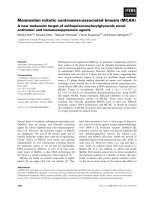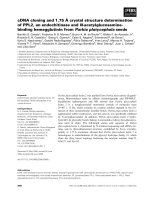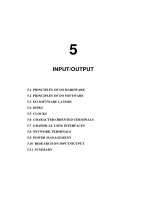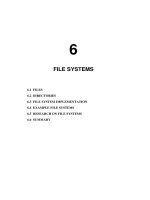A computer system consists of hardware, system programs, and application programs figs 10
Bạn đang xem bản rút gọn của tài liệu. Xem và tải ngay bản đầy đủ của tài liệu tại đây (413.07 KB, 40 trang )
10
CASE STUDY 1: UNIX AND LINUX
10.1 HISTORY OF UNIX
10.2 OVERVIEW OF UNIX
10.3 PROCESSES IN UNIX
10.4 MEMORY MANAGEMENT IN UNIX
10.5 INPUT/OUTPUT IN UNIX
10.6 THE UNIX FILE SYSTEM
10.7 SECURITY IN UNIX
10.8 SUMMARY
Users
Standards utility programs
(shell, editors, compliers etc)
Standard library
(open, close, read, write, fork, etc)
UNIX operating system
(process management, memory management,
the file system, I/O, etc)
Hardware
(CPU, memory, disks, terminals, etc)
User
interface
Library
interface
System
call
interface
User
mode
Kernel mode
Fig. 10-1. The layers in a UNIX system.
Program Typical use
cat Concatenate multiple files to standard output
chmod Change file protection mode
cp Copy one or more files
cut Cut columns of text from a file
grep Search a file for some pattern
head Extract the first lines of a file
ls List directory
make Compile files to build a binary
mkdir Make a directory
od Octal dump a file
paste Paste columns of text into a file
pr Format a file for printing
rm Remove one or more files
rmdir Remove a directory
sort Sort a file of lines alphabetically
tail Extract the last lines of a file
tr Translate between character sets
Fig. 10-2. A few of the common UNIX utility programs required
by
POSIX.
System calls Interrupts and traps
Terminal handing
Sockets
Network protocols
Routing
File
naming
Map-
ping
Page
faults
Signal
handling
Process
creation and
termination
Raw
tty
Cooked tty
Line
disciplines
Character
devices
Network
device drivers
Hardware
Disk
device drivers
Process
dispatching
Process
scheduling
Page
cache
Buffer
cache
File
systems
Virtual
memory
Fig. 10-3. Structure of the 4.4BSD kernel.
pid = fork( ); /
*
if the fork succeeds, pid > 0 in the parent
*
/
if (pid < 0) {
handle error( ); /
*
fork failed (e.g., memory or some table is full)
*
/
} else if (pid > 0) {
/
*
parent code goes here. /
*
/
} else {
/
*
child code goes here. /
*
/
}
Fig. 10-4. Process creation in UNIX.
Signal Cause
SIGABRT Sent to abort a process and force a core dump
SIGALRM The alarm clock has gone off
SIGFPE A floating-point error has occurred (e.g., division by 0)
SIGHUP The phone line the process was using has been hung up
SIGILL The user has hit the DEL key to interrupt the process
SIGQUIT The user has hit the key requesting a core dump
SIGKILL Sent to kill a process (cannot be caught or ignored)
SIGPIPE The process has written to a pipe which has no readers
SIGSEGV The process has referenced an invalid memory address
SIGTERM Used to request that a process terminate gracefully
SIGUSR1 Available for application-defined purposes
SIGUSR2 Available for application-defined purposes
Fig. 10-5. The signals required by POSIX.
System call Description
pid = fork( ) Create a child process identical to the parent
pid = waitpid(pid, &statloc, opts) Wait for a child to terminate
s = execve(name, argv, envp) Replace a process’ core image
exit(status) Terminate process execution and return status
s = sigaction(sig, &act, &oldact) Define action to take on signals
s = sigreturn(&context) Return from a signal
s = sigprocmask(how, &set, &old) Examine or change the signal mask
s = sigpending(set) Get the set of blocked signals
s = sigsuspend(sigmask) Replace the signal mask and suspend the process
s = kill(pid, sig) Send a signal to a process
residual = alarm(seconds) Set the alarm clock
s = pause( ) Suspend the caller until the next signal
Fig. 10-6. Some system calls relating to processes. The return code
s is −1 if an error has occurred, pid is a process ID, and residual is
the remaining time in the previous alarm. The parameters are what
the name suggests.
while (TRUE) { /
*
repeat forever /
*
/
type prompt( ); /
*
display prompt on the screen
*
/
read command(command, params); /
*
read input line from keyboard
*
/
pid = fork( ); /
*
fork off a child process
*
/
if (pid < 0) {
printf("Unable to fork0); /
*
error condition
*
/
continue; /
*
repeat the loop
*
/
}
if (pid != 0) {
waitpid (−1, &status, 0); /
*
parent waits for child
*
/
} else {
execve(command, params, 0);/
*
child does the work
*
/
}
}
Fig. 10-7. A highly simplified shell.
Thread call Description
pthread create Create a new thread in the caller’s address space
pthread exit Terminate the calling thread
pthread join Wait for a thread to terminate
pthread mutex init Create a new mutex
pthread mutex destroy Destroy a mutex
pthread mutex lock Lock a mutex
pthread mutex unlock Unlock a mutex
pthread cond init Create a condition variable
pthread cond destroy Destroy a condition variable
pthread cond wait Wait on a condition variable
pthread cond signal Release one thread waiting on a condition variable
Fig. 10-8. The principal POSIX thread calls.
sh sh ls
Fork code
Exec code
New process Same process
1. Fork call 3. exec call
4. sh overlaid
with ls
2. new sh
created
PID = 501 PID = 748 PID = 748
Allocate child's process table entry
Fill child's entry from parent
Allocate child's stack and user area
Fill child's user area from parent
Allocate PID for child
Set up child to share parent's text
Copy page tables for data and stack
Set up sharing of open files
Copy parent's registers to child
Find the executable program
Verify the execute permission
Read and verify the header
Copy arguments, environ to kernel
Free the old address space
Allocate new address space
Copy arguments, environ to stack
Reset signals
Initialize registers
Fig. 10-9. The steps in executing the command ls typed to the
shell.
Flag Meaning when set Meaning when cleared
CLONE VM Create a new thread Create a new process
CLONE FS Share umask, root, and working dirs Do not share them
CLONE FILES Share the file descriptors Copy the file descriptors
CLONE SIGHAND Share the signal handler table Copy the table
CLONE PID New thread gets old PID New thread gets own PID
Fig. 10-10. Bits in the sharing flags bitmap.
Highest
priority
Lowest
priority
-4
-3
-2
-1
0
0
1
2
3
Waiting for disk I/O
Waiting for disk buffer
Waiting for terminal input
Waiting for terminal output
Waiting for child to exist
User priority 0
User priority 1
User priority 2
User priority 3
Process queued
on priority level 3
Process waiting
in user mode
Process waiting
in kernel mode
Fig. 10-11. The UNIX scheduler is based on a multilevel queue
structure.
Process 0
Process 1 Process 2
Page
daemon
Terminal 0 Terminal 1 Terminal 2
Login:
Password: % cp f1 f2
login sh
cp
getty
init
Fig. 10-12. The sequence of processes used to boot some UNIX
systems.
Text
BSS
Data
Stack pointer
Stack pointer
20K
8K
0
Unused
memory
24K
8K
0K
BSS
Text
Data
(a) (b) (c)
OS
Physical memory
Process A Process B
Fig. 10-13. (a) Process A’s virtual address space. (b) Physical
memory. (c) Process B’s virtual address space.
Text
BSS
Data
Text
Stack pointer Stack pointer
20K
8K
0K
24K
0K
(a) (b) (c)
OS
Physical memory
Mapped file
Mapped file
Process A Process B
BSS
Data
8K
Unused
memory
Fig. 10-14. Two processes can share a mapped file.
System call Description
s = brk(addr) Change data segment size
a = mmap(addr, len, prot, flags, fd, offset) Map a file in
s = unmap(addr, len) Unmap a file
Fig. 10-15. Some system calls relating to memory management.
The return code s is −1 if an error has occurred; a and addr are
memory addresses, len is a length, prot controls protection, flags
are miscellaneous bits, fd is a file descriptor, and offset is a file
offset.
Page frame
3
Page frame
2
Page frame
1
Page frame
0
4.3 BSD
kernel
Two-handed
clock scans
core map
Main memory Core map entry
Core map
entries, one
per page frame
Index of next entry
Index of previous entry
Disk block number
Disk device number
Block hash code
Index into proc table
Text/data/stack
Offset within segment
Used when
page frame is
on the free list
Locked in
memory bit
WantedIn transitFree
Fig. 10-16. The core map in 4BSD.
Global
directory
Directory
Page
middle
directory
Page
table
Page
Word selected
Virtual addressOffsetPageMiddle
Fig. 10-17. Linux uses three-level page tables.
(a)
64
(b)
32
32
(d)
32
8
8
16
(e)
16
8
8
32
(f)
8
8
8
32
8
(g)
8
4
8
8
32
(h)
4
8
8
8
32
(i)
16
4
4
8
32
(c)
16
16
32
4
4
Fig. 10-18. Operation of the buddy algorithm.
User space
Kernel space
Receiving process
Sending process
Socket
Connection
Network
Fig. 10-19. The uses of sockets for networking.
Function call Description
s = cfsetospeed(&termios, speed) Set the output speed
s = cfsetispeed(&termios, speed) Set the input speed
s = cfgetospeed(&termios, speed) Get the output speed
s = cfgtetispeed(&termios, speed) Get the input speed
s = tcsetattr(fd, opt, &termios) Set the attributes
s = tcgetattr(fd, &termios) Get the attributes
Fig. 10-20. The main POSIX calls for managing the terminal.
Device Open Close Read Write Ioctl Other
Null null null null null null
Memory null null mem read mem write null
Keyboard k open k close k read error k ioctl
Tty tty open tty close tty read tty write tty ioctl
Printer lp open lp close error lp write lp ioctl
Fig. 10-21. Some of the fields of a typical cdevsw table.
File system
Buffer cache
Disk drivers
Terminal drivers
Line disciplines
User
space
Kernel
Disk
Reading/writing files
Cooked
interface to
/dev/tty
Raw interface
to/dev/tty
Fig. 10-22. The UNIX I/O system in BSD.
A
Stream head
TCP
IP
Ethernet driver
Ethernet controller
B
Stream head
TCP
Token ring driver
Token ring controller
Process
Ethernet
Token Ring
Computer
User mode
Kernel mode
Fig. 10-23. An example of streams in System V.
Directory Contents
bin Binary (executable) programs
dev Special files for I/O devices
etc Miscellaneous system files
lib Libraries
usr User directories
Fig. 10-24. Some important directories found in most
UNIX systems.









